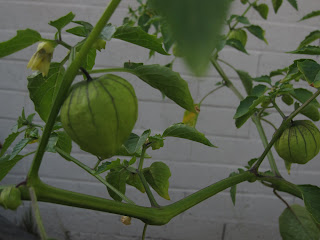Soups were a very important meal during my childhood. Whenever I was sick with a cold, my mom game me chicken soup to eat. There was a period of time in my childhood when I was very weak and I always got sick. My mom prepared soups rich in iron and vitamins that would help me get strong. Like most children in my family, I grew up loving soups, or caldos, as we called them.
This is a chicken caldo made with a Mexican twist. I love it because I prepare it with vegetables from my own back yard.
Chicken Caldo with Vegetables and Pasilla Peppers
2 Tablespoons of olive oil
1 small onion, finely chopped
2 garlic clove, minced
6 cups of water
2 chicken breasts, cleaned
2 sprigs of thyme, finely chopped
Salt to taste
2 pasilla peppers, seeded and deveined
10-15 tomatillos milpero (I like the very small and purple in color), cleaned and halved.
10-15 tomatillos milpero (I like the very small and purple in color), cleaned and halved.
3 small carrots, chopped
3-4 small zucchinis or summer squash, chopped
3 small potatoes, peeled and quartered
In a medium pot over slow fire, heat the oil. Add onion and garlic and sauté until translucent. Add the chicken, water, salt and thyme. Bring to a boil, reduce to simmer and cook for about 20 minutes . While the chicken cooks, soak the peppers in boiling water for 10 minutes. When soft, place in a blender with tthe tomatillos and a little bit of the soaking water and purée to make a sauce. Pass the sauce through a fine strainer to separate the solids and set aside. When the chicken is tender, remove from the pot and set aside to cool for a few minutes. Add the carrots and potatoes to the pot. Cook until vegetables become fork tender. Shred chicken and return to the pot. Add the zucchinis and pasilla sauce. If needed, correct the seasoning and simmer until the chicken and all the vegetables are cook thoroughly. Serve hot.
This other soup is really good. I learned how to make this soup from one of Giada De Laurentiis' cook books. This is a pea and sweet basil soup but I have made it with cilantro and with lemon basil and it tastes very good, too. I like to change, add or delete some of the ingredients to my taste. My changes are in italic.
Peas and Basil Soup
2 tablespoons olive oil
1 tablespoon butter (I do not use butter)
1 small onion, diced
1 clove garlic, minced
1 teaspoon of dried red pepper flakes (optional)
1 teaspoon salt
1/2 teaspoon freshly ground black pepper
1 1/2 pounds (about 4 1/2 cups) frozen peas
3/4 cup chopped fresh basil leaves
2 cups chicken broth, divided (vegetable broth)
2 cups cream (3/4 cup of cream)
4 to 6 very thin slices fresh mozzarella cheese (I haven't used cheese)
1/4 cup diced roasted red bell peppers (I haven't used peppers)
Place a medium soup pot over medium heat. Add the olive oil, butter (if using), onions, garlic, salt and pepper. Cook until the onions are soft and translucent, about 5 minutes. If using, add the pepper flakes and cook a few seconds longer. Add the peas and basil and heat until the peas are thawed (I do not add the basil at this point). Place the pea (here is where I add the basil) mixture in a blender. Add 1 cup of the broth and pulse until pureed, adding more broth, if necessary, to puree. Return the pureed mixture to the pot. Stir in the remaining broth and cream. Return the pan to medium heat and cook until hot, but not boiling.
To serve, place the soup in bowls. If using, float a thin slice of fresh mozzarella cheese on top of each soup and sprinkle with the diced roasted red bell peppers. Serve immediately.
Soups could be good for the soul but they also warm the heart and heal the body. I love them!




















































 Dragonfly
Dragonfly
